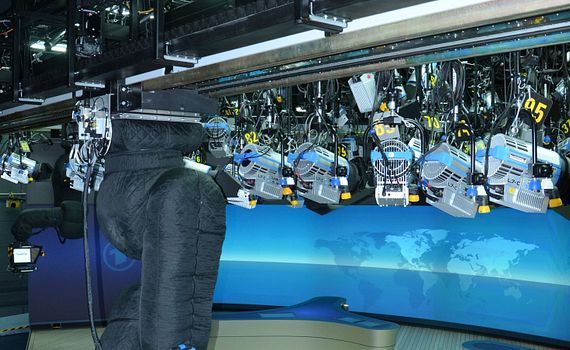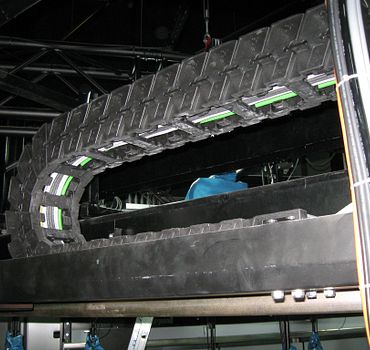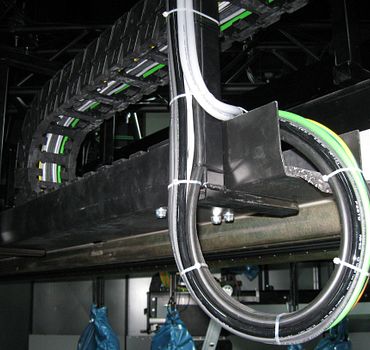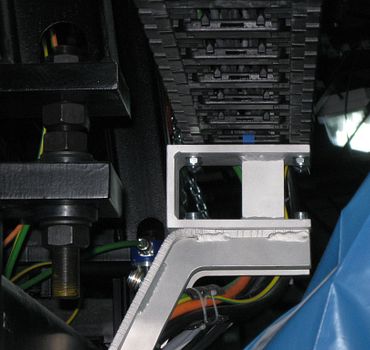Smooth-running energy chains for camera robots in the Tagesschau news studio
The cable guides have to work around the clock and at the same time be maintenance-free and quiet.
Since April 2014, all ARD-aktuell programs have been produced in a new television studio that is equipped with state-of-the-art technology. A highlight are three camera robots suspended under the ceiling that implement camera shots with smooth movements and the highest precision. Smooth running, low vibration and wear resistance are the main requirements for the plastic energy chains for guiding the extensive cable packages. Consulting skills also played an extremely important role in the extensive project.Profile
- What was needed: E6 energy chains, chainflex control cables, guide trough
- Requirements: Smooth running, freedom from maintenance, long service life, fluid, jerk-free movements
- Industry: Film and camera technology
- Success for the customer: The E6 type e-chain achieves a long running performance that can be calculated in advance. Abrasion-resistant interface connectors and a small pitch ensure extremely quiet and low-vibration operation. A special solution was developed for the longest travel with a custom-made moving end, special support rollers, rubber-coated plastic rollers or special suspensions for the guide trough.

Problem
The Tagesschau news studio is staffed almost around the clock. The ARD flagship is not only used for 20 daily editions of Tagesschau, the Tagesthemen and the Nachtmagazin, but also for the Tagesschau news every quarter of an hour on the digital channel called 'tagesschau24'. The presentation of current events is in the foreground, and the technology must always work.So when the Tagesschau studio was to be completely overhauled and modernised, the technical equipment also had to be reconsidered. The focus is on a semi-circular media wall around 18 metres wide behind the speakers' seats. It can be used with panorama images, photos, videos and text overlays. Seven beamers project the changing background images onto the media wall. The question was how this stage set could best be orchestrated for the audience.
In order to reliably capture walkways and fade-ins, a conscious decision was made not to use camera cranes and to use modern robot cameras that move on linear rails under the ceiling. The full-service provider XXX for turnkey robot solutions made no compromises when designing them. Since all systems had to run absolutely error-free from the first minute of transmission, only components that guarantee a long service life and are maintenance-free were considered for used. This also applies to the cable guidance to the moving camera robots. The six-axis industrial robots weigh around 300 kilograms. With all the necessary equipment, a mass of around 500 kilograms is moved each time. From the teleprompter and all the necessary cables and hoses up to the safety technology: a fill weight of at least 30 kilograms per metre weighs on the cable guidance. Accordingly, there was much need for discussion when it came to choosing the right energy supply.
Solution
It was clear early on in the project that our plastic energy supply systems would be used in the robot system. The focus of the considerations was the long running performance, which can be calculated in advance, but also the variety of energy chains.Specifically, open energy supply systems of the E6 series with an inner height of 80 millimetres and a bend radius of 150 millimetres have proven themselves in all three camera robots used. The travels are 12 metres, 8 metres and 6.50 metres. The series has a modular structure, which means that the chain can be shortened or lengthened at any point. Even more important is the special structure of the chain links: abrasion-resistant interface connectors and the small pitch enable extremely quiet and low-vibration operation in the news studio. The dreaded polygon effect when rolling does not occur at any time.
While the two cameras were used on the shorter travels with unsupported energy chains (upper and lower runs do not touch), a special solution is used on the 12m travel. Due to the length of the chain, the upper run would be deposited on the lower run when moving. In order to prevent grinding noises and wear and tear of the material during the process, a custom-made moving end with special support rollers was chosen. Three rubber-coated plastic rollers catch the upper run. In addition, there are special suspensions for the guide trough, which accommodate the centrally fed chain. In addition, the trough system is designed with insulating mats.
In order to guarantee long-term functional reliability, shielded control cables from the chainflex product range suitable for energy chains are also used in the camera robots. This is because it is particularly important to avoid shield wire breaks, which can lead to short circuits or reduced shielding effectiveness. Among other things, this is prevented by a tight overall braided shield of the chainflex cables, which have been specially developed for use in energy chains. The shield also exerts torsion protection on the stranded structure.



Extensive consulting and joint project planning led to success.
The final energy supply in the news studio was not determined at the beginning. Instead, finding a solution turned out to be an extensive process of collaborative working to provide the best possible response to the requirements in the studio environment.For example, an energy supply of the universal E4.1 system was originally intended for the long travel. Since the individual chain links, which were too large, clattered with every movement and made grinding noises, the background noise here was too high. A classic gliding application was therefore ruled out. In the run-up to the design, the supplier of the studio robots had no idea what a central role the energy supply would play in this project. Another key to success was the advice from our sales representative, who was available at all times and worked out a quick solution to all problems with his colleagues. The extensive advice extended far beyond the actual design of the energy supply. Assistance was also provided on the topics of selecting the material for the support rollers, insulating mats for the trough system and the design of the moving end. In addition to the uncomplicated cooperation, unnecessary delays could also be avoided thanks to quick sampling.
